I (like many planar speaker owners, I suspect) are forced to have my Martin Logan Sequel IIs too close to the front wall. After some experimentation, I began to understand that the upper midrange glare and diffuse imaging I was hearing was due to the back wave from the dipoles. And, after some other mods documented on this site, this back wave seemed to become more energetic to the point of making the speakers tiring. I was able to prove the need for damping the back wave by clamping a couple of sheepskin rugs to the back of the speakers. I needed a more permanent solution to damping the back wave that would also address the WAF. While in my local Lowe's I spotted a product called ProVent by ADO Products. It is thin plastic, 14" by 48", costs $1.88 each and looks like this:
![IMGDEAD]](/community/proxy.php?image=http%3A%2F%2F%5BIMGDEAD%5Dhttps%3A%2F%2Fi99.photobucket.com%2Falbums%2Fl294%2Fatkinsonrr%2FAudio%2520Obsession%2Feabbecea.jpg%5B%2FIMGDEAD%5D&hash=dc24fd5754d82a5abfc5e95c52d3099a)
The ProVent is a perfect width for affixing to the back of the Sequel II. I suspect that a few other models of Martin Logan have the same 14" width so ProVent will fit also fit those models without modification. Also, the ProVent has wide flanges where it would attach and those flanges could be cut down to accommodate speakers down to about 11" wide.
For the Sequel II the ProVent must be cut down to 42" length. Scissors are adequate to cut the vent. You can try using the ProVent as a rear baffle just as it is. For temporary attachment I used sticky putty. In my situation, placing the ProVent behind the Sequels helped, but they still sounded bright overall. I was also concerned about cancellation effects from sound reflecting back from the ProVent.
I considered various materials for absorbing the back wave. I rejected fiberglass for health reasons, rejected rigid board sound insulation because it would be difficult to work with and due to expense; I rejected Sonex-type foam again due to cost and also because it deteriorates over time. At my local craft store, I found 1" loft polyester batting at a cost of $14.99:
![IMGDEAD]](/community/proxy.php?image=http%3A%2F%2F%5BIMGDEAD%5Dhttps%3A%2F%2Fi99.photobucket.com%2Falbums%2Fl294%2Fatkinsonrr%2FAudio%2520Obsession%2F760d83bb.jpg%5B%2FIMGDEAD%5D&hash=b62e23f18afb94249ed87297695074a6)
To cut the batting to fit into the cavity of the ProVent, cutting the batting along its 96" length into three strips of 9" wide, 10" wide and 11" wide. I then cut each strip into two 48" lengths. Before cutting, its a good idea to put the batting in the dryer for 10 minutes to increase the loft and take out creases.
![IMGDEAD]](/community/proxy.php?image=http%3A%2F%2F%5BIMGDEAD%5Dhttps%3A%2F%2Fi99.photobucket.com%2Falbums%2Fl294%2Fatkinsonrr%2FAudio%2520Obsession%2F196b1caf.jpg%5B%2FIMGDEAD%5D&hash=12b92f4fe1c3d886fa9b4e11945009f6)
I affixed the three strips to the inside of the Provent using spray glue: first the 9" width then the 10" and finally the 11". I let the extra 6" length of the batting trail out what would be the bottom of the baffle. The completed baffle looks like this:
![IMGDEAD]](/community/proxy.php?image=http%3A%2F%2F%5BIMGDEAD%5Dhttps%3A%2F%2Fi99.photobucket.com%2Falbums%2Fl294%2Fatkinsonrr%2FAudio%2520Obsession%2Fa1930aed.jpg%5B%2FIMGDEAD%5D&hash=6dfa9402adce40080df56398cd74dc80)
I then temporarily mounted the baffles on the back of the Sequels using sticky putty. With three layers of 1" polyester, the speakers sound great. BTW I also tried the baffles with only one layer of 1" batting and they sounded absolutely terrible--worse then without any damping at all! Here you can see the reason for the extra 6" of batting on the bottom of the baffle:
![IMGDEAD]](/community/proxy.php?image=http%3A%2F%2F%5BIMGDEAD%5Dhttps%3A%2F%2Fi99.photobucket.com%2Falbums%2Fl294%2Fatkinsonrr%2FAudio%2520Obsession%2F9ec8e6fd.jpg%5B%2FIMGDEAD%5D&hash=9b8eec1d6ab814ece94073c8760c0cfc)
As you can see, the baffles are quite handsome mounted on the back of the Sequels:
![IMGDEAD]](/community/proxy.php?image=http%3A%2F%2F%5BIMGDEAD%5Dhttps%3A%2F%2Fi99.photobucket.com%2Falbums%2Fl294%2Fatkinsonrr%2FAudio%2520Obsession%2F94d835f9.jpg%5B%2FIMGDEAD%5D&hash=eb111bca6c0bca3b647a6dc5a60b9137)
I just received self adhering velcro tape that I ordered from Ebay and will be using that for the permanent attachment of the baffles.
![IMGDEAD]](/community/proxy.php?image=http%3A%2F%2F%5BIMGDEAD%5Dhttps%3A%2F%2Fi99.photobucket.com%2Falbums%2Fl294%2Fatkinsonrr%2FAudio%2520Obsession%2Feabbecea.jpg%5B%2FIMGDEAD%5D&hash=dc24fd5754d82a5abfc5e95c52d3099a)
The ProVent is a perfect width for affixing to the back of the Sequel II. I suspect that a few other models of Martin Logan have the same 14" width so ProVent will fit also fit those models without modification. Also, the ProVent has wide flanges where it would attach and those flanges could be cut down to accommodate speakers down to about 11" wide.
For the Sequel II the ProVent must be cut down to 42" length. Scissors are adequate to cut the vent. You can try using the ProVent as a rear baffle just as it is. For temporary attachment I used sticky putty. In my situation, placing the ProVent behind the Sequels helped, but they still sounded bright overall. I was also concerned about cancellation effects from sound reflecting back from the ProVent.
I considered various materials for absorbing the back wave. I rejected fiberglass for health reasons, rejected rigid board sound insulation because it would be difficult to work with and due to expense; I rejected Sonex-type foam again due to cost and also because it deteriorates over time. At my local craft store, I found 1" loft polyester batting at a cost of $14.99:
![IMGDEAD]](/community/proxy.php?image=http%3A%2F%2F%5BIMGDEAD%5Dhttps%3A%2F%2Fi99.photobucket.com%2Falbums%2Fl294%2Fatkinsonrr%2FAudio%2520Obsession%2F760d83bb.jpg%5B%2FIMGDEAD%5D&hash=b62e23f18afb94249ed87297695074a6)
To cut the batting to fit into the cavity of the ProVent, cutting the batting along its 96" length into three strips of 9" wide, 10" wide and 11" wide. I then cut each strip into two 48" lengths. Before cutting, its a good idea to put the batting in the dryer for 10 minutes to increase the loft and take out creases.
![IMGDEAD]](/community/proxy.php?image=http%3A%2F%2F%5BIMGDEAD%5Dhttps%3A%2F%2Fi99.photobucket.com%2Falbums%2Fl294%2Fatkinsonrr%2FAudio%2520Obsession%2F196b1caf.jpg%5B%2FIMGDEAD%5D&hash=12b92f4fe1c3d886fa9b4e11945009f6)
I affixed the three strips to the inside of the Provent using spray glue: first the 9" width then the 10" and finally the 11". I let the extra 6" length of the batting trail out what would be the bottom of the baffle. The completed baffle looks like this:
![IMGDEAD]](/community/proxy.php?image=http%3A%2F%2F%5BIMGDEAD%5Dhttps%3A%2F%2Fi99.photobucket.com%2Falbums%2Fl294%2Fatkinsonrr%2FAudio%2520Obsession%2Fa1930aed.jpg%5B%2FIMGDEAD%5D&hash=6dfa9402adce40080df56398cd74dc80)
I then temporarily mounted the baffles on the back of the Sequels using sticky putty. With three layers of 1" polyester, the speakers sound great. BTW I also tried the baffles with only one layer of 1" batting and they sounded absolutely terrible--worse then without any damping at all! Here you can see the reason for the extra 6" of batting on the bottom of the baffle:
![IMGDEAD]](/community/proxy.php?image=http%3A%2F%2F%5BIMGDEAD%5Dhttps%3A%2F%2Fi99.photobucket.com%2Falbums%2Fl294%2Fatkinsonrr%2FAudio%2520Obsession%2F9ec8e6fd.jpg%5B%2FIMGDEAD%5D&hash=9b8eec1d6ab814ece94073c8760c0cfc)
As you can see, the baffles are quite handsome mounted on the back of the Sequels:
![IMGDEAD]](/community/proxy.php?image=http%3A%2F%2F%5BIMGDEAD%5Dhttps%3A%2F%2Fi99.photobucket.com%2Falbums%2Fl294%2Fatkinsonrr%2FAudio%2520Obsession%2F94d835f9.jpg%5B%2FIMGDEAD%5D&hash=eb111bca6c0bca3b647a6dc5a60b9137)
I just received self adhering velcro tape that I ordered from Ebay and will be using that for the permanent attachment of the baffles.
I have done a little experimenting with dampening the back wave before and this is what I have found,
http://www.diyaudio.com/forums/planars-exotics/187654-beveridge-vs-traditional-esl.html#post2548352
There maybe another thread where I describe my setup in more detail and if I find it I will post the link for you.
The change in the sound was subtle but noticeable.
I didn't much care for it as it takes away from the sound of them being free and open and effortless, persay.
But if this doesn't bother you then I would say it is a viable alternative as it is a very subjective topic and I will do some more studies on this sometime again.
I use my little panels on my computer desk and they sit back in the cubby holes and there is quite alot of of reflection and diffractions going on.
I used the corner of the little woofer box as a beam splitter and that worked very well for my nearfield situation.
The idea of reducing the back wave appeals to me very much in some applications as my room and listening space is much too small to properly setup a dipole speaker.
I am not new to this as I also have a set of Apogee Duette's.
But as I mentioned the ability for the free movement of the diagphram and the loading of it effects how it sounds and is what concerns me the most.
I have been investigating the possibilty of close proximity reflecting surfaces behind the diagphram.
It works as well and needs to be investigated further as Charlie's Beam Splitter setup seems to work very well for him.
I have also done a few experiments of using some glass panels directly behind my little panels of 3.25" X 9.75" at different angles.
All of my tests were done in mono to check for such lobing characteristics so listening in stereo will be interesting for me as I am quite behind on my projects.
But the main reason for listening in mono was to not be distracted from having two sources and other reflections caused from multiple sources.
I have been thinking more of a cylindrical type of reflector directly behind the diagphram and I am think about trying this with my next build of some 6" wide by 8' tall panels.
Although the diffractions could cause the lobing effect to worsen.
It really depends on your room as mine is 10.5 wide by 18.5 deep and the side wall reflections reverse my right to left information by the time it reaches my listening area that is 12' to 14' away from the speakers, as there is no room treatment at this time.
So in my case, them being very directional is a good thing.
jer
http://www.diyaudio.com/forums/planars-exotics/187654-beveridge-vs-traditional-esl.html#post2548352
There maybe another thread where I describe my setup in more detail and if I find it I will post the link for you.
The change in the sound was subtle but noticeable.
I didn't much care for it as it takes away from the sound of them being free and open and effortless, persay.
But if this doesn't bother you then I would say it is a viable alternative as it is a very subjective topic and I will do some more studies on this sometime again.
I use my little panels on my computer desk and they sit back in the cubby holes and there is quite alot of of reflection and diffractions going on.
I used the corner of the little woofer box as a beam splitter and that worked very well for my nearfield situation.
The idea of reducing the back wave appeals to me very much in some applications as my room and listening space is much too small to properly setup a dipole speaker.
I am not new to this as I also have a set of Apogee Duette's.
But as I mentioned the ability for the free movement of the diagphram and the loading of it effects how it sounds and is what concerns me the most.
I have been investigating the possibilty of close proximity reflecting surfaces behind the diagphram.
It works as well and needs to be investigated further as Charlie's Beam Splitter setup seems to work very well for him.
I have also done a few experiments of using some glass panels directly behind my little panels of 3.25" X 9.75" at different angles.
All of my tests were done in mono to check for such lobing characteristics so listening in stereo will be interesting for me as I am quite behind on my projects.
But the main reason for listening in mono was to not be distracted from having two sources and other reflections caused from multiple sources.
I have been thinking more of a cylindrical type of reflector directly behind the diagphram and I am think about trying this with my next build of some 6" wide by 8' tall panels.
Although the diffractions could cause the lobing effect to worsen.
It really depends on your room as mine is 10.5 wide by 18.5 deep and the side wall reflections reverse my right to left information by the time it reaches my listening area that is 12' to 14' away from the speakers, as there is no room treatment at this time.
So in my case, them being very directional is a good thing.
jer
Last edited:
A cylindrical diffusor will do the job. I've done that in the past.
I got my inspiration from E. Fikier who presented its hybrid design in the magazine Elektuur; it consisted of three pvc tubes, one of them being the backwave diffusor.
Unfortynately such large (pvc) tube doesnt't look very pretty and you have to mount it somewhere below and above the panel. I don't know whether the tube still causes some backwave reflaction as I didn't perform a/b comparison with a totally free standing esl, but the tube can placed against the wall and will sound better than without a tube in that case.
heavy damping with baf seems to worsen sound quality to my ears.
I got my inspiration from E. Fikier who presented its hybrid design in the magazine Elektuur; it consisted of three pvc tubes, one of them being the backwave diffusor.
Unfortynately such large (pvc) tube doesnt't look very pretty and you have to mount it somewhere below and above the panel. I don't know whether the tube still causes some backwave reflaction as I didn't perform a/b comparison with a totally free standing esl, but the tube can placed against the wall and will sound better than without a tube in that case.
heavy damping with baf seems to worsen sound quality to my ears.
Very cool,MJ !!
I would like to see more info on that technique if it is possible.
What is the ratio of the tube diameter compared to the width of the panel.
This is something that I have contemplating for quite some time as I don't need too wide of a dispersion.
I have used flat surfaces at different angles with some success.
I had also tried closing up the back of the panel in very close proximity with some glass and it had an interesting effect as well.
It seemed to raise the efficiency by some factor due to the instant combining of the back wave to the front wave from the reflection off of the plane that was only no more than 3/8" away from the diagphram.
That is about all of the experimentation I did as I was working on transformers and diagphram coatings at the time.
I know I had expressed my findings in more detail on trying to stuff the back of the panel with some fiberglass insulation, But I just spent 3 hours trying to find the post and failed to find it.
I think it was part of a thread where the last half of the thread some how for some reason got deleted.
The "Different idea's for esl's" thread as I had posted alot of info there and now it is gone and I remember when it happened as I was not to happy.
jer
I would like to see more info on that technique if it is possible.
What is the ratio of the tube diameter compared to the width of the panel.
This is something that I have contemplating for quite some time as I don't need too wide of a dispersion.
I have used flat surfaces at different angles with some success.
I had also tried closing up the back of the panel in very close proximity with some glass and it had an interesting effect as well.
It seemed to raise the efficiency by some factor due to the instant combining of the back wave to the front wave from the reflection off of the plane that was only no more than 3/8" away from the diagphram.
That is about all of the experimentation I did as I was working on transformers and diagphram coatings at the time.
I know I had expressed my findings in more detail on trying to stuff the back of the panel with some fiberglass insulation, But I just spent 3 hours trying to find the post and failed to find it.
I think it was part of a thread where the last half of the thread some how for some reason got deleted.
The "Different idea's for esl's" thread as I had posted alot of info there and now it is gone and I remember when it happened as I was not to happy.
jer
What I remember is that the diameter of the pvc pipe was around the same as the width of the mylar film. The distance between the pipe (outer edge) and film is approx. 20 cm. See Do It Yourself - Electrostatic Speakers - Project: ESL 175 by Martin-Jan Dijkstra for a picture.
Please note the construction techniques described are outdated; these were some of my first projects.
According to E. Fikier the tubes can filled with sand (he put the dynamic woofer on top of the tubes) , but using them only as diffractor this is not needed.
Please note the construction techniques described are outdated; these were some of my first projects.
According to E. Fikier the tubes can filled with sand (he put the dynamic woofer on top of the tubes) , but using them only as diffractor this is not needed.
Rob
One thing about geting more or what should be output of the Any panel, an the top being tipup......all one has to do is lean the speakers back....kant...i think the seq dont lean back much.. an at a 90dg you do get more out put...But if you look at the SL3 on up you well see thay can lay back....the new ones like summit i had here for a time are almost at a 45dg....sounded way rolled of..thay were dark...the owner was freaktout when i pulled them up...thay open up....looket weard the base was facing more to the floor....anywho...there are pasives way to deal with the top being to hot...keep on diying...thanks
One thing about geting more or what should be output of the Any panel, an the top being tipup......all one has to do is lean the speakers back....kant...i think the seq dont lean back much.. an at a 90dg you do get more out put...But if you look at the SL3 on up you well see thay can lay back....the new ones like summit i had here for a time are almost at a 45dg....sounded way rolled of..thay were dark...the owner was freaktout when i pulled them up...thay open up....looket weard the base was facing more to the floor....anywho...there are pasives way to deal with the top being to hot...keep on diying...thanks
I use my little panels on my computer desk and they sit back in the cubby holes and there is quite alot of of reflection and diffractions going on.
I used the corner of the little woofer box as a beam splitter and that worked very well for my nearfield situation.
Jer: Can we see a pic of these little ESL's of yours?
Yes here are some links,
http://www.diyaudio.com/forums/planars-exotics/162127-different-ideas-esl-panels.html#post2111911
http://www.diyaudio.com/forums/planars-exotics/158115-material-esl-2.html#post2075441
http://www.diyaudio.com/forums/plan...tor-insulation-mylar-coating.html#post2530753
http://www.diyaudio.com/forums/plan...t-panel-angles-8-vs-9-panels.html#post2170405
http://www.diyaudio.com/forums/planars-exotics/109789-esl-diaphragm-coating-7.html#post2142822
http://www.diyaudio.com/forums/planars-exotics/109789-esl-diaphragm-coating-8.html#post2144443
http://www.diyaudio.com/forums/planars-exotics/109789-esl-diaphragm-coating-8.html#post2151765
http://www.diyaudio.com/forums/planars-exotics/109789-esl-diaphragm-coating-8.html#post2160477
http://www.diyaudio.com/forums/planars-exotics/109789-esl-diaphragm-coating-8.html#post2162068
and pictures of my micro esl,
http://www.diyaudio.com/forums/planars-exotics/158115-material-esl-2.html#post2076459
http://www.diyaudio.com/forums/planars-exotics/158115-material-esl-2.html#post2074212
Enjoy !!!

jer
http://www.diyaudio.com/forums/planars-exotics/162127-different-ideas-esl-panels.html#post2111911
http://www.diyaudio.com/forums/planars-exotics/158115-material-esl-2.html#post2075441
http://www.diyaudio.com/forums/plan...tor-insulation-mylar-coating.html#post2530753
http://www.diyaudio.com/forums/plan...t-panel-angles-8-vs-9-panels.html#post2170405
http://www.diyaudio.com/forums/planars-exotics/109789-esl-diaphragm-coating-7.html#post2142822
http://www.diyaudio.com/forums/planars-exotics/109789-esl-diaphragm-coating-8.html#post2144443
http://www.diyaudio.com/forums/planars-exotics/109789-esl-diaphragm-coating-8.html#post2151765
http://www.diyaudio.com/forums/planars-exotics/109789-esl-diaphragm-coating-8.html#post2160477
http://www.diyaudio.com/forums/planars-exotics/109789-esl-diaphragm-coating-8.html#post2162068
and pictures of my micro esl,
http://www.diyaudio.com/forums/planars-exotics/158115-material-esl-2.html#post2076459
http://www.diyaudio.com/forums/planars-exotics/158115-material-esl-2.html#post2074212
Enjoy !!!

jer
I am at this very moment getting them set back up, now that I have finished the power supply.
I had blown up one panel so I am working on it right now as we speak.
I have resealed it where one screen had gotten ripped and gave it another coat of clear acrylic.
The other panel is fine and takes every thing my supply can produce.
The supply produces 13.8Kv and the meter shows 5.2Kv so it is leaking some where but at least it is not profusely arcing.
It just sits there nice and quiet like it is supposed to do.
It is funny as I turn up the voltage it just stays about 5.4kv to 5.2kv like it hit a brickwall like a zener diode acts.
I believe that this is the point where the the air is starting to conduct and works out to be around 70v to 75v per mil for my D/S spacing .072" to .075".
I will see if I have some better photos in my archives and if not I will make some new ones.
This will be the first time I have been able to fire them up again(he,he,he, pun intended) since october of 2010 when the one exploded into flames, and will be in stereo as well.
I already fixed the frames and the diaghpram is fine,So all I have to do is paint on a new charge ring and bolt it back together as long as the stators pass the arc tests to at least 6Kv to 7Kv.
Most of the panel already does except for a few spots that is why I had to give them another shot of clear acrylic.
Basicaly what I did was lean the little panel against the corner of the little sony speakers that I used as woofers only (duct tape on the tweeter works good) and shoved them back in the cubby holes where the upper shelves are and is wide open.
Right now there is a monitor in one of those spaces so I may have to move the monitor or change it out for one of my smaller ones.
jer
I had blown up one panel so I am working on it right now as we speak.
I have resealed it where one screen had gotten ripped and gave it another coat of clear acrylic.
The other panel is fine and takes every thing my supply can produce.
The supply produces 13.8Kv and the meter shows 5.2Kv so it is leaking some where but at least it is not profusely arcing.
It just sits there nice and quiet like it is supposed to do.
It is funny as I turn up the voltage it just stays about 5.4kv to 5.2kv like it hit a brickwall like a zener diode acts.
I believe that this is the point where the the air is starting to conduct and works out to be around 70v to 75v per mil for my D/S spacing .072" to .075".
I will see if I have some better photos in my archives and if not I will make some new ones.
This will be the first time I have been able to fire them up again(he,he,he, pun intended) since october of 2010 when the one exploded into flames, and will be in stereo as well.
I already fixed the frames and the diaghpram is fine,So all I have to do is paint on a new charge ring and bolt it back together as long as the stators pass the arc tests to at least 6Kv to 7Kv.
Most of the panel already does except for a few spots that is why I had to give them another shot of clear acrylic.
Basicaly what I did was lean the little panel against the corner of the little sony speakers that I used as woofers only (duct tape on the tweeter works good) and shoved them back in the cubby holes where the upper shelves are and is wide open.
Right now there is a monitor in one of those spaces so I may have to move the monitor or change it out for one of my smaller ones.
jer
Last edited:
Here are the pictures that I had posted but couldn't find.
I was working on three things here,
1# Canceling the back wave,but no pictures of the fiberglass insulation or top baffle.
2# The effect of multiple panels and their angles.
3# how many panels it took match the same output level of the 5.25" woofer box at the same power level,it took 2 but 3 was even better.
This was before I had gotten my big amps back from Florida.
The frequency response curve are no EQ and EQed for one open panel.
The measurements were done with a Peavey PVM-520TN and a Phillips PSC706 16bit card.
The irregularities I am sure where from room reflections as later I had gotten a ruler flat response with no EQ with the panel at a different position in the room and added some room treatment to dampen the mid and high frequency reverberations.
I will be doing this measurement again as I now have a Gina24 24bit 96khz card and a Dayton measurement microphone with the calibration data as well as a SPL meter.
jer
I was working on three things here,
1# Canceling the back wave,but no pictures of the fiberglass insulation or top baffle.
2# The effect of multiple panels and their angles.
3# how many panels it took match the same output level of the 5.25" woofer box at the same power level,it took 2 but 3 was even better.
This was before I had gotten my big amps back from Florida.
The frequency response curve are no EQ and EQed for one open panel.
The measurements were done with a Peavey PVM-520TN and a Phillips PSC706 16bit card.
The irregularities I am sure where from room reflections as later I had gotten a ruler flat response with no EQ with the panel at a different position in the room and added some room treatment to dampen the mid and high frequency reverberations.
I will be doing this measurement again as I now have a Gina24 24bit 96khz card and a Dayton measurement microphone with the calibration data as well as a SPL meter.
jer
Attachments
-
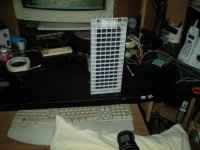 open setup(new).jpg100 KB · Views: 94
open setup(new).jpg100 KB · Views: 94 -
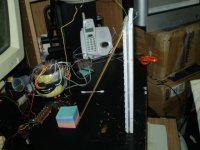 open side view.jpg56 KB · Views: 92
open side view.jpg56 KB · Views: 92 -
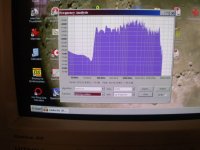 open no eq.jpg50.4 KB · Views: 88
open no eq.jpg50.4 KB · Views: 88 -
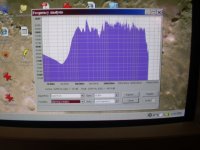 old eq'ed,+6db 200hz,+9db 12khz.jpg49.5 KB · Views: 85
old eq'ed,+6db 200hz,+9db 12khz.jpg49.5 KB · Views: 85 -
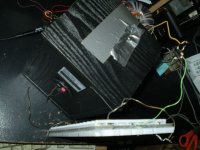 beam splitter top view.jpg56.4 KB · Views: 91
beam splitter top view.jpg56.4 KB · Views: 91 -
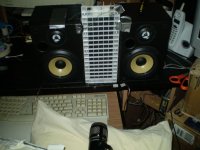 P3240369.jpg102.8 KB · Views: 42
P3240369.jpg102.8 KB · Views: 42 -
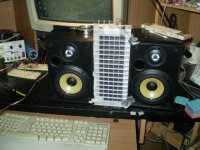 single panel setup.jpg65.3 KB · Views: 38
single panel setup.jpg65.3 KB · Views: 38 -
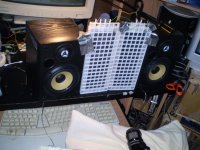 testsetup for both.jpg127.2 KB · Views: 42
testsetup for both.jpg127.2 KB · Views: 42 -
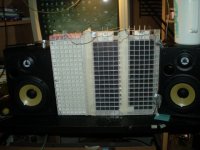 three panel setup.jpg55.6 KB · Views: 43
three panel setup.jpg55.6 KB · Views: 43
Yes,that is the technique that Charlie has incorporated in his design.
Hopefully tomorrow I will find out how well it will work in stereo with the little panels, as I have only used them in mono so far.
When I did try it it seemed to have a better horizontal dispersion with less refraction of the rear wave reflecting off of the back panel of my desk.
Since I listen to them near field I may not notice any difference at all.
The proof will be when I move them out in front of my mixer or towards the middle of the room in a more open area.
I will start a new thread on these as not to clutter up this one.
I will be doing a lot of retesting on these with my new measurement tools as the tests that I posted almost 2 years ago were the best that I could do without any reference standard to go by.
I have been wanting to try some sort of acoustic lens or a small horn flare as well to finally put light on that idea as if it would be a benefit or not work at all for a small sized driver like these.
These things can and do get really really loud with an amplifier that can deliver the goods.

jer
Hopefully tomorrow I will find out how well it will work in stereo with the little panels, as I have only used them in mono so far.
When I did try it it seemed to have a better horizontal dispersion with less refraction of the rear wave reflecting off of the back panel of my desk.
Since I listen to them near field I may not notice any difference at all.
The proof will be when I move them out in front of my mixer or towards the middle of the room in a more open area.
I will start a new thread on these as not to clutter up this one.
I will be doing a lot of retesting on these with my new measurement tools as the tests that I posted almost 2 years ago were the best that I could do without any reference standard to go by.
I have been wanting to try some sort of acoustic lens or a small horn flare as well to finally put light on that idea as if it would be a benefit or not work at all for a small sized driver like these.
These things can and do get really really loud with an amplifier that can deliver the goods.

jer
Sorry about this repost But I didn't realise that I was in edit mode and I went over the 30 minute limit.
jer
Yes, That is the technique that Charlie has incorporated in his design.
Hopefully tomorrow I will find out how well it will work in stereo with the little panels, as I have only used them in mono so far.
When I did try it it seemed to have a better horizontal dispersion with less refraction of the rear wave reflecting off of the back panel of my desk.
The midrange hump in the frequency curve was most likely the refelctions off of the monitor as that distance is roughly the same as when they were set back into the cubby hole listening position.
As well as the early high frequency roll off may have been caused by the measuring devices limits.
Since I listen to them near field I may not notice any difference at all.
But it sure will be nice to listen to them again.
I was just absolutely floored listening even in mono.
So it is going to be a real treat now that I have the proper equipment to drive them now.
The proof will be when I move them out in front of my mixer or towards the middle of the room in a more open area.
I will start a new thread on these as not to clutter up this one.
I will be doing a lot of retesting on these with my new measurement tools as the tests that I posted almost 2 years ago were the best that I could do without any reference standard to go by.
I have been wanting to try some sort of acoustic lens or a small horn flare as well to finally put light on that idea as if it would be a benefit or not work at all for a small sized driver like these.
These things can and do get really really loud with an amplifier that can deliver the goods,in which BTW at the time I only had one stereo amplifier so one channel drove the ESL and the other drove the woofer.
Right now I am focusing on the fact that they sound so good rather than them being dipole drivers as my room is just not big (wide)enough for full blown dipole system to reach the sound levels I am trying to achieve.
But Sound quality does come first, although the I listen mostly to modern music(Rock-N-roll), I like all forms of music even orchestras ,everything!
This sometimes is a big undertaking for just one set or type of speakers.
How things sound is very subjective so I don't use fancy words to describe it as it either sounds good or something is wrong and needs to be fixed.
So therefore I won't criticize one for trying something new because it may be what works for ones particular application or situation for what ever reason.
I think that closing up the back of the ML is very interesting and is something that I and many others have been curious about and has been discussed over and over.
Hence the question "Can an ESL be put in a box or an enclosure?".
When I did my little experiment of filling of the back of the panel I did notice a little high end finesse was dampened a bit but not enough to destroy the sound of the panel or added any coloration as the sound quality was still there.
I have heard many dynamic tweeters and midranges that sounded much worse,in fact that is kinda what it sounded like.
Much like when I first powered them up after seven years and they were loaded up with extra mass form dirt and sand with the much thicker Licron original formula as the coating.
Had I been listening to them in stereo I might not have noticed it at all.
I had found that it must have been the added pressure behind the diagphram that was was causing this and as I moved the insulation back from the panel to about 8" the finesse started to come back.
This setup was fully open and the appratus became to large for my desk and become very messy to work with.
I did get more bass output though which was what I was after.
My conclusion was that, It may be quite feasible for a larger panel were the mass the of the diagphram is much greater to overcome the added back preasure but not for my little panels.

jer
jer
Yes, That is the technique that Charlie has incorporated in his design.
Hopefully tomorrow I will find out how well it will work in stereo with the little panels, as I have only used them in mono so far.
When I did try it it seemed to have a better horizontal dispersion with less refraction of the rear wave reflecting off of the back panel of my desk.
The midrange hump in the frequency curve was most likely the refelctions off of the monitor as that distance is roughly the same as when they were set back into the cubby hole listening position.
As well as the early high frequency roll off may have been caused by the measuring devices limits.
Since I listen to them near field I may not notice any difference at all.
But it sure will be nice to listen to them again.
I was just absolutely floored listening even in mono.
So it is going to be a real treat now that I have the proper equipment to drive them now.
The proof will be when I move them out in front of my mixer or towards the middle of the room in a more open area.
I will start a new thread on these as not to clutter up this one.
I will be doing a lot of retesting on these with my new measurement tools as the tests that I posted almost 2 years ago were the best that I could do without any reference standard to go by.
I have been wanting to try some sort of acoustic lens or a small horn flare as well to finally put light on that idea as if it would be a benefit or not work at all for a small sized driver like these.
These things can and do get really really loud with an amplifier that can deliver the goods,in which BTW at the time I only had one stereo amplifier so one channel drove the ESL and the other drove the woofer.
Right now I am focusing on the fact that they sound so good rather than them being dipole drivers as my room is just not big (wide)enough for full blown dipole system to reach the sound levels I am trying to achieve.
But Sound quality does come first, although the I listen mostly to modern music(Rock-N-roll), I like all forms of music even orchestras ,everything!
This sometimes is a big undertaking for just one set or type of speakers.
How things sound is very subjective so I don't use fancy words to describe it as it either sounds good or something is wrong and needs to be fixed.
So therefore I won't criticize one for trying something new because it may be what works for ones particular application or situation for what ever reason.
I think that closing up the back of the ML is very interesting and is something that I and many others have been curious about and has been discussed over and over.
Hence the question "Can an ESL be put in a box or an enclosure?".
When I did my little experiment of filling of the back of the panel I did notice a little high end finesse was dampened a bit but not enough to destroy the sound of the panel or added any coloration as the sound quality was still there.
I have heard many dynamic tweeters and midranges that sounded much worse,in fact that is kinda what it sounded like.
Much like when I first powered them up after seven years and they were loaded up with extra mass form dirt and sand with the much thicker Licron original formula as the coating.
Had I been listening to them in stereo I might not have noticed it at all.
I had found that it must have been the added pressure behind the diagphram that was was causing this and as I moved the insulation back from the panel to about 8" the finesse started to come back.
This setup was fully open and the appratus became to large for my desk and become very messy to work with.
I did get more bass output though which was what I was after.
My conclusion was that, It may be quite feasible for a larger panel were the mass the of the diagphram is much greater to overcome the added back preasure but not for my little panels.

jer
Last edited:
I noticed that Sound Lab has another small ESL hybrid, the WallStat, in addition to their MiniStat, so perhaps the arrangement is not a dead end (so to speak)? Both seem to 'absorb' the rear wave (but then also use a lens on the front, which I don't care for, philosophically!).
How do these sound, and is it worthwhile to DIY something like this for a desktop ESL?
How do these sound, and is it worthwhile to DIY something like this for a desktop ESL?
That is a very good question.
Those are some avenues that I had intended to explore.
To me the magic of the ESL is not because they are a dipole driver but because of the inherently low THD that they produce.
With the right materials and consideration of proper dimensions to me they blow away dynamic drivers in most respects for the costs envolved.
In the last 20 and even within the last 10 years the materials have taken quite a leap to be able to make DIY ESL's even a feasibility,namley coatings and especially transformers.
My very first listen of an ESL was the MartinLogans just before I had finished my 8" X 22" panels.
Then I built my little panels modeled after my very first panels made out of some perforated aluminium material that had a very low open area and poor performance because of it .
The idea between the two sizes was one was 4 times larger than the other and I wanted to see if this actually would be 6db more efficient.
But the struggle of not having some decent transformers had set me back a bit until two years ago when I got back into it.
But I did have a good coating system down as I had built two sets of little ones,one using spray paint (one of those got lost) and the other set used powder coating,and what a world of difference the extra open area made using the PC method not to mention being able to run a much higher bias voltage.
But all in all they all sounded the same as the ML's that I had first listened to.
With the exception of bass extension they added no coloration to the sound and are clean and crystal clear.
So much so that they even fooled my dog into thinking it was raining and storming outside and refused to go out because of it, When the moon was out and shining brightly with no cloud in the sky.
I was listening to a tape of forrest sounds,Yes, A cassette tape!
He,he,he you had to be there to see that one !!!
This completely amazed me for such a smal set of speakers.
And for what it is worth I liked the narrower panels more because they were less beamy than even my 8" wide panels.
In recent studies I finally found out why this is.
This was all back in the summer of 2003 before I had access to my big power amps that at the time were powering the same Appoge Duette's that I now have.
And even then although they were underpowered and no bass system they sounded better than those Duette's and I loved those speakers.
I still do but they are in sad shape and I don't have the room to properly set them up.
jer
Those are some avenues that I had intended to explore.
To me the magic of the ESL is not because they are a dipole driver but because of the inherently low THD that they produce.
With the right materials and consideration of proper dimensions to me they blow away dynamic drivers in most respects for the costs envolved.
In the last 20 and even within the last 10 years the materials have taken quite a leap to be able to make DIY ESL's even a feasibility,namley coatings and especially transformers.
My very first listen of an ESL was the MartinLogans just before I had finished my 8" X 22" panels.
Then I built my little panels modeled after my very first panels made out of some perforated aluminium material that had a very low open area and poor performance because of it .
The idea between the two sizes was one was 4 times larger than the other and I wanted to see if this actually would be 6db more efficient.
But the struggle of not having some decent transformers had set me back a bit until two years ago when I got back into it.
But I did have a good coating system down as I had built two sets of little ones,one using spray paint (one of those got lost) and the other set used powder coating,and what a world of difference the extra open area made using the PC method not to mention being able to run a much higher bias voltage.
But all in all they all sounded the same as the ML's that I had first listened to.
With the exception of bass extension they added no coloration to the sound and are clean and crystal clear.
So much so that they even fooled my dog into thinking it was raining and storming outside and refused to go out because of it, When the moon was out and shining brightly with no cloud in the sky.
I was listening to a tape of forrest sounds,Yes, A cassette tape!
He,he,he you had to be there to see that one !!!
This completely amazed me for such a smal set of speakers.
And for what it is worth I liked the narrower panels more because they were less beamy than even my 8" wide panels.
In recent studies I finally found out why this is.
This was all back in the summer of 2003 before I had access to my big power amps that at the time were powering the same Appoge Duette's that I now have.
And even then although they were underpowered and no bass system they sounded better than those Duette's and I loved those speakers.
I still do but they are in sad shape and I don't have the room to properly set them up.
jer
- Status
- This old topic is closed. If you want to reopen this topic, contact a moderator using the "Report Post" button.
- Home
- Loudspeakers
- Planars & Exotics
- A Back Wave Baffle for Martin Logans